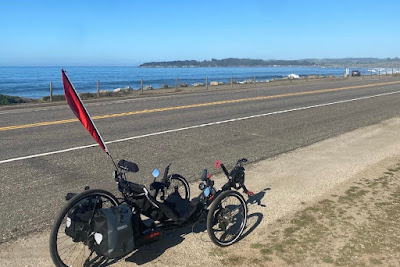Occasionally, but rarely, an upright cyclist somehow will show their discontent with having to share the road with what they see as an outrageously oversized obstacle (me) in the road that impedes their Strava record attempt. The overwhelming majority of cyclists are totally cool although curious at times. But non the less let's get real about size.
Some facts
The handle bar width on a traditional road bike is 15" to 18" (380mm to 460mm).
On a mountain bike or a bike with straight bars the width is 27" to 31" (680mm to 800mm).
Note: the average adult male is 16.1" (409 mm) from shoulder to shoulder. For a female it's 14.4" (366mm).
The width of my trike and most trikes for that matter at the front wheels is 32" (812mm).
Now my not so serious opinionated thoughts
So why do handful of people in the cycling community complain about trikes taking up too much room? Maybe some are just prejudiced against anything that is not two wheels and upright (thanks UCI). Others probably mean well but still think we take up more space than we actually do.
Yes a trike is heavier, bulkier and a few inches or millimeters wider but how much of the road do we actually require?
Now let's get real, the casual traditional cyclist is not going to be able to maintain a straight line for any significant amount of time, especially on a rough road. They "wobble". So when figuring out how much space they actually need consider how the rider is going to wobble around (the "wobble factor" for lack of a better term).
With my e-assist I can easily pass the average cyclist going up a hill and also going down because I'm pushing less air. So I'm doing a of lot passing. By the time I'm up to passing an upright cyclist I've already made a judgment about how much room I need to allow for a rider and their wobble. It's pretty easy to make out an experienced rider who is not going to wobble into you. If they're fit and wearing the proper "I want to be in the Tour de France" couture and maintaining reasonable control of their ride then I can pretty much be confident in their anti-wobble skills. For the less than experienced wobbly rider I'll give up to three feet of extra space when passing.
Now for my anti-wobble skills (other trikes as well) I know I present a straight and smooth track to riders, traditional or whatever, coming up from behind. If you're wobbling on three wheels you're probably drunk and should get off the road but otherwise three wheels on the ground is a no brainer for not wobbling. It's common for experienced riders (the ones with the well developed tanned calves) to pass close, very close, to me. They obviously see that I can maintain a straight line and it doesn't hurt that I acknowledge their intention to pass with a wave.
Again...the overwhelming majority of cyclists on the road are totally cool and we wave to each other while riding and usually start up a conversation while taking a break. There are a lot cyclists on my regular routes so I have the opportunity to know them in passing. But it's that 1/100 traditional cyclist who gives me a "get out of my way glare or gesture" that makes you want to scratch your head and say "what the hey". But I don't let it cloud my positive attitude to cyclists in general no matter what they ride or wear.
................................
Now I know there are other factors that determine how much room is needed on a recumbent trike vs a traditional bike. I've heard "a real bike can ride closer to the curb". No experienced two wheeler is going to ride the curb but a trike can dip an inside wheel towards the curb with no harm to self when the situation calls for it and so on and so forth.
Riding on Multi Use Paths (MUPs) is a whole topic onto itself. And sense I do very little trail riding I'll leave that topic alone.
That's all for my little light hearted treatise on the subject. Just stay save, wave and be aware.

















